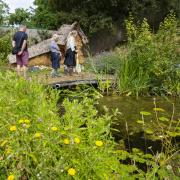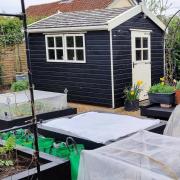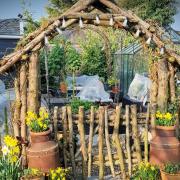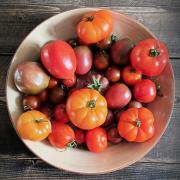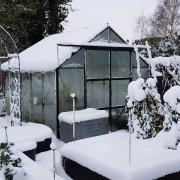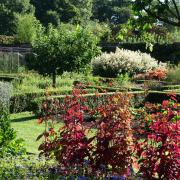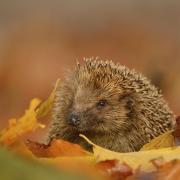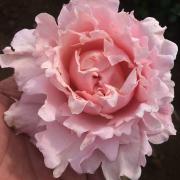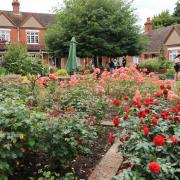Here’s how you can have a stunning Suffolk garden like horticulturalist Henrietta Neuteboom’s

Leaves and berries of every hue from burnished toffee to mellow yellow and ruby red are nature’s grand finale before the gloom of winter descends. Henrietta Neuteboom’s beautiful garden in the heart of rural Suffolk shows autumn in all its blazing glory.
Year-round, Henrietta spends hours outside propagating and planting or simply enjoying the wonder of the mighty oaks surrounding the wildflower meadow she can see from her veranda.
It’s hard to believe she had no special plan for the garden when she and husband Dan built their Finnish-style wooden house in the middle of an orchard near Eye 20 years ago. But then, not surprisingly being a horticulturalist, she was busy growing plants all the time they were preparing for the move.
“After the building we levelled the ground and prepared the meadow for wildflowers. The area round the house lent itself to a little shrubbery and next to that a vegetable garden. But the meadow with trees round it. That was very important. I love trees.”

The stars of the show this year have been her three Liquidambar trees, one resplendent with glossy burgundy leaves at the end of the garden path on the edge of the meadow.
See also: How to have colour in your garden from spring to autumn

Another sensation is the perfectly conical Acer rubrum, the Canadian red maple, with its vivid red and orange autumn tones.
Strolling through the shrubbery there are eye-catching Berberis ‘Georgii’ with masses of shiny red berries against green and yellow foliage and the beady round berries of cotoneaster.
Scrambling up a tree is the multi-coloured foliage of the vine Vitis ‘Brant’ and, as we reach the meadow, the impressive sight of the medlar Mespilus germanica, with its bronze fruit against dazzling yellow foliage. It’s fascinating to think this fruit was cultivated way back in Roman times.
Closer to the house are the great clumps of miscanthus grasses, with silvery fronds waving in the breeze above their lovely yellow and green stems.

Henrietta and I are both agreed that making the most of our gardens, out in the fresh air whatever the time of year, brings health and mental wellbeing at this difficult time. And it’s impossible to leave this garden without paying respect to those magnificent oaks that Henrietta loves, four of them over 200 years old and each taking on their own autumn shades.
Never forget to look up is the message, wherever you happen to be in our glorious Suffolk countryside.
Read Marion’s blog at gardeneast.blog/author/marionwelham

WHAT MAKES AUTUMN COLOUR?
The science of autumn colour can be challenging if studied in detail but, suffice to say, changes in colour are caused by pigments that are capable of absorbing and reflecting light. Chlorophyll, which reflects mainly green light, is produced in large amounts when the plant is actively growing, making the leaves appear mostly green. But there are small amounts of other pigments – the yellow and red ones (carotenoids, as in carrots) which show up in autumn when the chlorophyll breaks down.
Five garden plants for reliable autumn colour

Pyracanthas, the firethorns, are evergreen climbers with stunning red or yellow berries that are favourites for birds. You can train this plant 12 x 8 metres against a wall or fence, or use it for an evergreen hedge. The long spikes can be brutal and will deter intruders.
Euonymus, the spindle family, are a good choice for autumn colour especially if your space is limited. Euonymus alatus compactus can even be grown in a pot. It has small greenish flowers, followed by purple fruit and stunning pinky-red foliage in autumn.
Cotinus coggygria, the smoke bush, is a candidate for a larger garden, having a height of 10-15 ft with an equal spread. The May-July flowers turn delightfully to fluff which last well into autumn and provide a stunning foil to large leaves as they take on autumn tones. A popular variety of the species is ‘Royal Purple’ and there is also is a dwarf variety with purple leaves called ‘Lilla’.
Berberis, the Japanese Barberry. Berberis thunbergia ‘Georgei’ has arching branches and small yellow flowers in late spring followed by deep red berries. It grows to around 6 ft tall x 4 ft wide. ‘Bagatelle’ is much more compact and has purple foliage brightening in autumn.
Liquidambar styraciflua, the sweet gum, is a favourite of Henrietta but can reach large proportions. A recent introduction is ‘Gum Ball’ which grows no more than 12 ft high and 6ft wide but with the same lovely maple-like foliage of the species and described as a dense “lollipop” canopy of foliage atop a perfectly straight stem.




